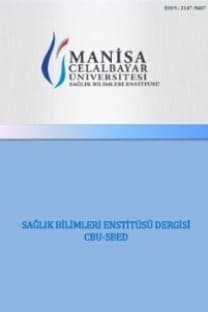The Effect of Vacuum Assisted Closure Treatment on Postsurgical Lower Extremity Groin Wounds and Secondary Lymphatic Complications
Vakum Yardımlı Kapatma Tedavilerinin Alt Ekstremitede Cerrahi Sonrası Kasık Bölgesi Yaraları ve Sekonder Lenfatik Komplikasyonlara Etkisi
___
1. Inui T, Bandyk DF, Vascular surgical site infection: risk factors and preventive measures, Seminars in Vascular Surgery, 2015, 28(3–4), 201–7. https://linkinghub.elsevier.com/retrieve/pii/S0895796716000065.2. Kwon J, Staley C, McCullough M, Goss S, Arosemena M, Abai B, et al, A randomized clinical trial evaluating negative pressure therapy to decrease vascular groin incision complications, Journal of Vascular Surgery, 2018, 68(6), 1744–52.
3. Bennett KM, Levinson H, Scarborough JE, Shortell CK, Validated prediction model for severe groin wound infection after lower extremity revascularization procedures, Journal of Vascular Surgery, 2016, 63(2), 414–9.
4. Jorgensen MG, Toyserkani NM, Hyldig N, Chakera AH, Hölmich LR, Thomsen JB, et al, Prevention of seroma following inguinal lymph node dissection with prophylactic, incisional, negativepressure wound therapy (SEROMA trial): study protocol for a randomized controlled trial, Trials, 2018, 15, 19(1), 441.
5. Moody JA, Botham SJ, Dahill KE, Wallace DL, Hardwicke JT, Complications following completion lymphadenectomy versus therapeutic lymphadenectomy for melanoma - A systematic review of the literature, European Journal of Surgical Oncology, 2017, 43(9), 1760–7.
6. Labanaris AP, Polykandriotis E, Horch RE, The effect of vacuumassisted closure on lymph vessels in chronic wounds, Journal of Plastic, Reconstructive & Aesthetic Surgery: JPRAS, 2009,62,1068-1075.
7. Yadav S, Rawal G, Baxi M, Vacuum assisted closure technique: a short review, The Pan African Medical Journal, 2017, 28, 246.
8. Fernandez LG, Matthews MR, Sibaja Alvarez P, Norwood S, Villarreal DH, Closed Incision Negative Pressure Therapy: Review of the Literature, Cureus, 2019, 21, 11(7), Se5183.
9. Frazee R, Manning A, Abernathy S, Isbell C, Isbell T, Kurek S, et al, Open vs Closed Negative Pressure Wound Therapy for Contaminated and Dirty Surgical Wounds: A Prospective Randomized Comparison, Journal of the American College of Surgeons, 2018, 226(4), 507–12. http://dx.doi.org/10.1016/j.jamcollsurg.2017.12.008
10. Willy C, Engelhardt M, Stichling M, Grauhan O, The impact of surgical site occurrences and the role of closed incision negative pressure therapy, International Wound Journal, 2016, 13(3), 35– 46.
11. Lee K, Murphy PB, Ingves MV, Duncan A, DeRose G, Dubois L, et al, Randomized clinical trial of negative pressure wound therapy for high-risk groin wounds in lower extremity revascularization, Journal of Vascular Surgery, 2017, 66(6), 1814–9.
12. Blum KS, Karaman S, Proulx ST, Ochsenbein AM, Luciani P, Leroux J-C, et al, Chronic high-fat diet impairs collecting lymphatic vessel function in mice, PLoS ONE, 2014, 9(4), Se94713.
13. Ma Z, Li Z, Shou K, Jian C, Li P, Niu Y, et al, Negative pressure wound therapy: Regulating blood flow perfusion and microvessel maturation through microvascular pericytes, International Journal of Molecular Medicine, 2017, 40(5), 1415–25.
14. Yuan Y, Niu Y, Xiao W, Qi B, Hu X, Yu A, The Effect and Mechanism of Negative Pressure Wound Therapy on Lymphatic Leakage in Rabbits, The Journal of Surgical Research, 2019, 235, 329–39.
15. Glass GE, Murphy GF, Esmaeili A, Lai L-M, Nanchahal J, Systematic review of molecular mechanism of action of negativepressure wound therapy, The British Journal of Surgery, 2014, 101(13), 1627–36.
16. Jorgensen MG, Toyserkani NM, Thomsen JB, Sørensen JA, Prophylactic incisional negative pressure wound therapy shows promising results in prevention of wound complications following inguinal lymph node dissection for Melanoma: A retrospective case-control series, Journal of Plastic, Reconstructive & Aesthetic Surgery: JPRAS, 2019, 72(7), 1178–83.
17. Willy C, Agarwal A, Andersen CA, Santis GD, Gabriel A, Grauhan O, et al, Closed incision negative pressure therapy: international multidisciplinary consensus recommendations, International Wound Journal, 2017, 14(2), 385–98.
18. Koetje JH, Ottink KD, Feenstra I, Fritschy WM, Negative Pressure Incision Management System in the Prevention of Groin Wound Infection in Vascular Surgery Patients, Surgery Research and Practice, 2015, Epub. doi: 10.1155/2015/303560.
19. Matatov T, Reddy KN, Doucet LD, Zhao CX, Zhang WW. Experience with a new negative pressure incision management system in prevention of groin wound infection in vascular surgery patients. Journal of Vascular Surgery, 2013, 57(3), 791–5.
- ISSN: 2147-9607
- Yayın Aralığı: 4
- Başlangıç: 2014
- Yayıncı: Manisa Celal Bayar Üniversitesi Sağlık Bilimleri Enstitüsü
Astım Hastalarında Tedavinin Nitrik Oksit ve Asimetrik Dimetil Arginin Düzeylerine Etkisi
Sükeynet AYDIN, Cahit BİLGİN, Asuman DEVECİ ÖZKAN, Ayşe ERDOĞAN ÇAKAR, Mehmet AKDOĞAN, Mehtap ERDOĞAN
Ebelik Öğrencilerinin Hasta Güvenliği Konusundaki Düşünceleri ve Tıbbi Hata Yapma Eğilimleri
Rukiye DEMİR, Damla KIZILCA ÇAKALOZ, Ayten TAŞPINAR, Ayden ÇOBAN
Knowledge And Attitudes Towards Genetic Testing In Those Affected With Chronic Diseases
Covid-19 Hastalarında Temel ve İleri Yaşam Desteği Algoritmaları
Gönül TEZCAN KELEŞ, Onur KUMCU
Hemodiyaliz Hastalarında Sigara Kullanımı, Nikotin Bağımlılık Durumu Ve İlişkili Faktörler
Zeynep KENDİ ÇELEBİ, Didem TURGUT
Brakiterapi Alan Serviks ve Endometium Kanserli Hastalarda Cinsel İşlevsellik ve Etkileyen Faktörler
Covid-19 Erişkin Hastada Temel ve İleri Yaşam Desteği Algoritmaları
Gönül TEZCAN KELEŞ, Onur KUMCU
Dilşad AMANVERMEZ ŞENARSLAN, Funda YILDIRIM, Mustafa CERRAHOĞLU
GEBELİKTE ALINAN PROTEİNİN YENİDOĞAN DOĞUM AĞIRLIĞI ÜZERİNE ETKİSİ
